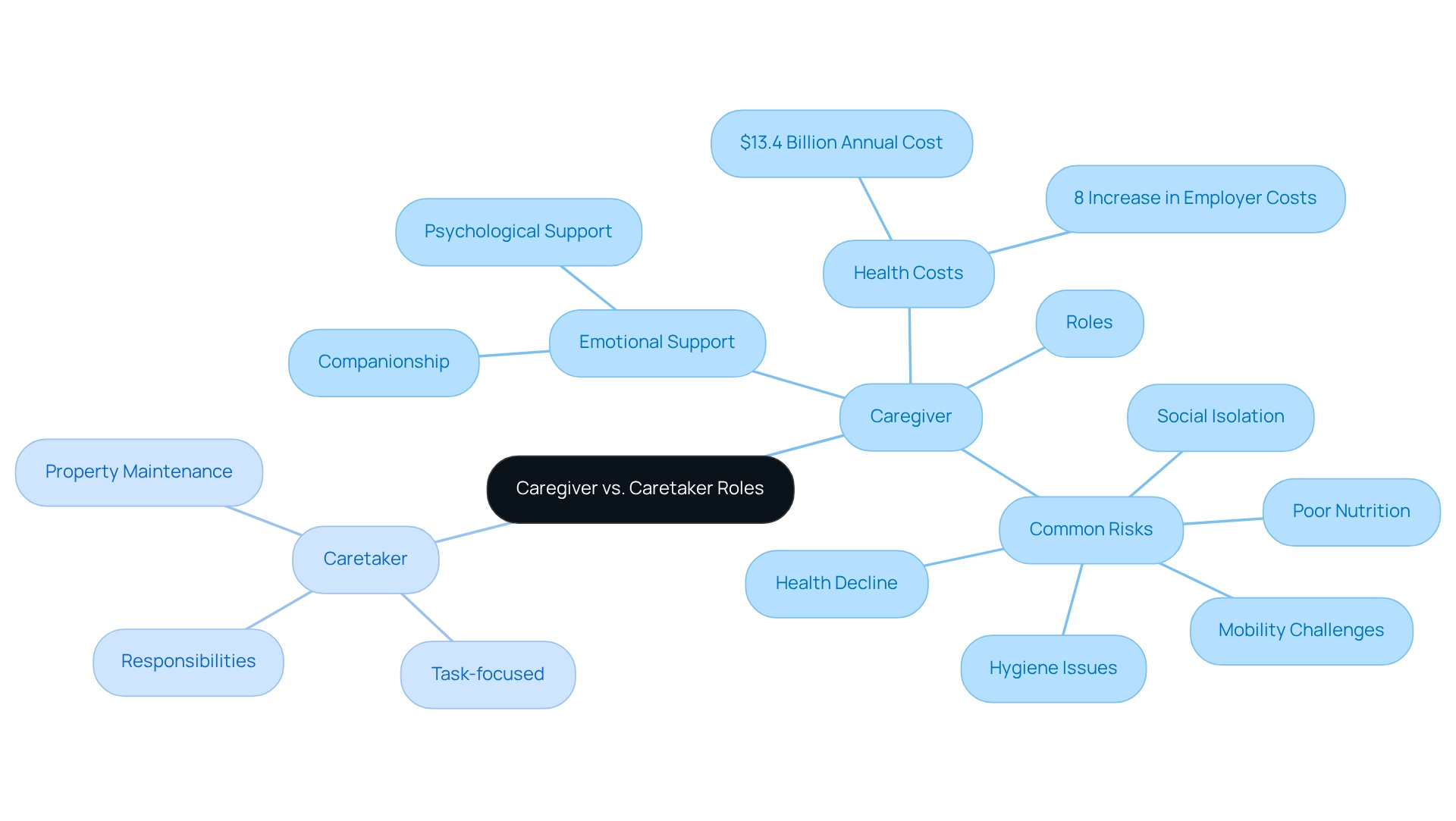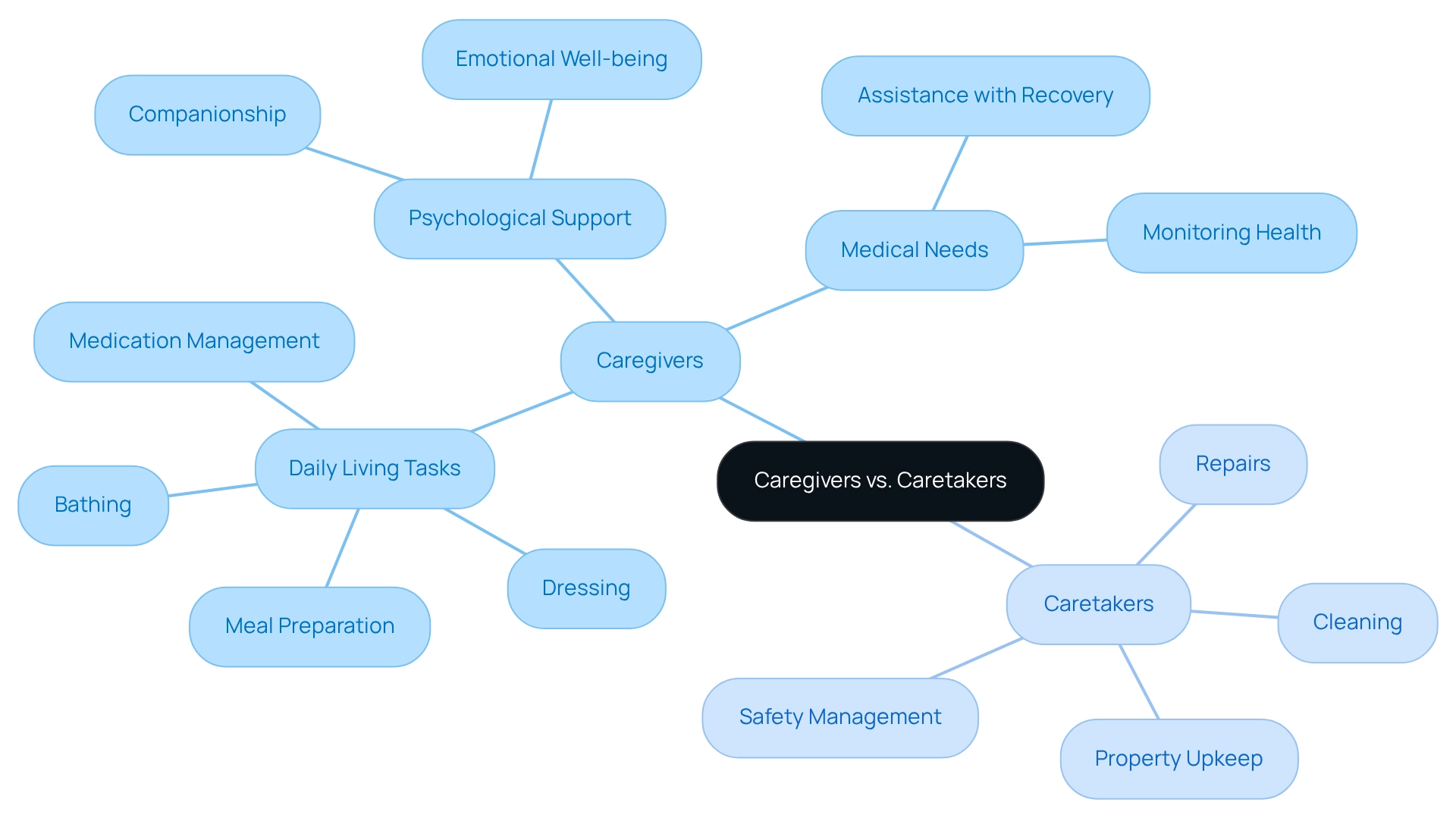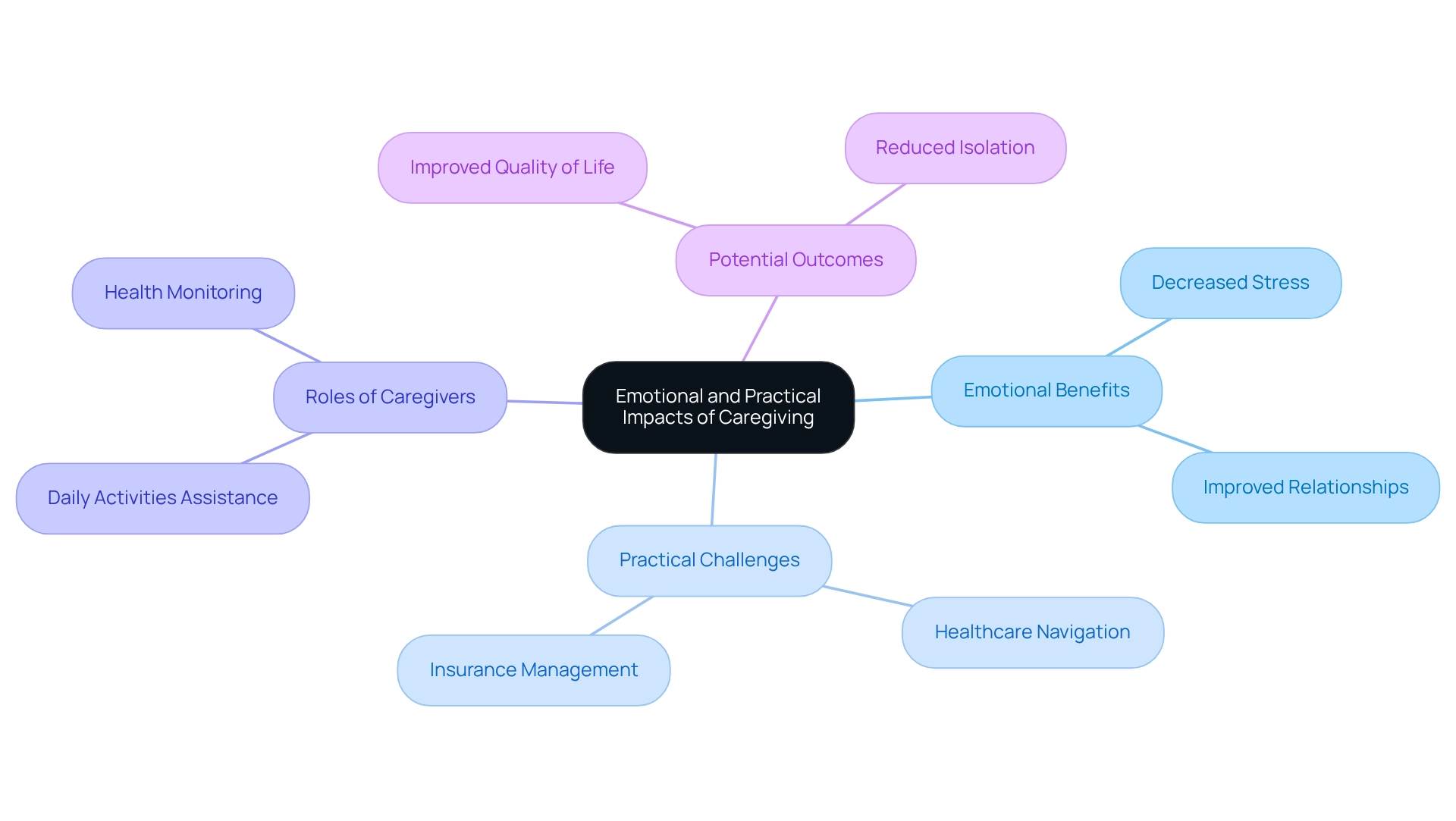Overview
Understanding the key differences between a care taker and a caregiver is essential for families seeking the right support. Caregivers primarily focus on personal assistance and emotional support, providing a nurturing presence that significantly enhances the quality of life for their clients through direct interaction and comprehensive care. In contrast, care takers manage physical environments and maintenance tasks, ensuring safety and upkeep.
Recognizing these roles can help families make informed decisions about the care they need. Caregivers offer invaluable emotional support, while care takers create safe and well-maintained spaces. This understanding underscores the importance of finding the right balance of care for your loved ones. Remember, we’re here for you, and your comfort is our priority as you navigate these choices.
Introduction
In the intricate landscape of caregiving, understanding the distinct roles of caregivers and caretakers is essential for families seeking the best support for their loved ones. Caregivers, often Certified Nursing Assistants (CNAs) or Home Health Aides (HHAs), provide vital personal and emotional care, enhancing the quality of life for individuals who are unable to care for themselves. They engage in a myriad of responsibilities, from assisting with daily activities to offering companionship, addressing both physical and emotional needs.
In contrast, caretakers focus primarily on the maintenance and upkeep of the physical environment. They ensure safety and functionality without necessarily forming deep emotional connections. This article delves into the nuanced differences and similarities between these two roles, exploring their respective impacts on families.
Choosing the right type of support is crucial for fostering well-being in vulnerable populations. Your comfort is our priority, and understanding these roles can help guide families in making informed decisions that resonate with their needs.
Define Caregiver and Caretaker Roles
A care taker is an individual who provides direct assistance and guidance to those who may struggle to care for themselves, including the elderly, children, or individuals with long-term health conditions. These care takers engage in personal assistance duties, offer psychological support, and provide companionship, all aimed at enhancing the quality of life for their clients. In contrast, a caretaker typically refers to an individual responsible for the maintenance and upkeep of properties or facilities, such as buildings or grounds. While a care taker may also look after individuals, their role tends to be more task-focused and less emotionally involved than that of those providing personal support. This distinction is crucial, as it highlights the varying levels of investment and types of responsibilities each role encompasses.
Statistics reveal that a significant percentage of providers offer emotional support, underscoring the importance of their role in the well-being of those they assist. Notably, employees with caregiving responsibilities incur an estimated 8% more in health care costs for their employers, amounting to an additional $13.4 billion each year. Expert opinions further clarify that those who provide care are vital in creating a nurturing environment, especially for seniors and individuals with chronic conditions. Without CNA/HHA services, seniors face numerous risks, including:
- Health decline due to lack of medical monitoring
- Poor nutrition from insufficient meal preparation
- Hygiene issues that can lead to infections
Furthermore, support providers help alleviate mobility challenges, reducing the likelihood of falls, and offer companionship to combat social isolation, which may lead to depression. They also assist with medication management and household tasks, ensuring a safer living environment.
Understanding these differences is essential for families seeking appropriate care taker solutions, as it directly influences the type of support required for their loved ones. Moreover, the case study titled “Work-Life Balance for Those Providing Care” illustrates the significant challenges individuals encounter in balancing work and caregiving, reinforcing the importance of recognizing their role. It is also critical to note that only 7% of elder abuse cases are reported to authorities, emphasizing the vital nature of caregivers in safeguarding vulnerable populations. To engage caregiver services effectively, families can follow three simple steps:
- Call to discuss needs
- Create a personalized support plan
- Choose compassionate providers to work with

Compare Responsibilities of Caregivers and Caretakers
Caregivers play a crucial role in enhancing the well-being of their clients through a diverse array of responsibilities. These include helping with daily living tasks such as bathing, dressing, meal preparation, and medication management, alongside offering psychological support. Care providers, especially Certified Nursing Assistants (CNAs) and Home Health Aides (HHAs), are educated to meet both medical and personal support needs, ensuring a holistic approach to assistance. In contrast, the care taker primarily focuses on the physical environment, handling tasks such as cleaning, performing minor repairs, managing property upkeep, and ensuring safety within the premises. While there is some overlap between the two roles, the distinction lies in their core focus. Individuals providing support prioritize the personal and psychological needs of those they care for, while care takers focus on the physical aspects of support and maintenance. For instance, support providers may dedicate an average of 20 hours weekly to personal care activities, demonstrating their commitment to the emotional and physical health of their clients.
Expert insights indicate that the duties of support providers go beyond simple task execution; they greatly influence the quality of life for those they help. A study highlighted that family supporters provide services valued at approximately $306 billion annually, underscoring their vital role in the healthcare system. Moreover, numerous individuals providing care express experiencing the pressure of juggling their caregiving responsibilities with professional obligations, which can impact their job performance and general well-being. In fact, employees with caregiving duties incur an estimated 8% more in healthcare expenses, totaling an additional $13.4 billion annually, demonstrating the broader influence of caregiving on the healthcare system.
Real-world examples show the daily challenges encountered by those providing care. For example, a support provider might assist an elderly client in managing the intricacies of medication schedules while also offering companionship, thereby attending to both physical and emotional needs. In contrast, a care taker might ensure that the living environment is safe and well-maintained, allowing the provider to concentrate on direct client support. Furthermore, grasping the need for CNA/HHA services is essential for families evaluating elderly assistance requirements. Indicators such as difficulty with personal hygiene, managing medications, or recovering from surgeries can signify the necessity for professional help. The typical family supporter for an individual aged 50 or older spent $5,531 annually on out-of-pocket assistance expenses in 2007, which represented over 10% of their median earnings, emphasizing the financial strain they frequently endure.
Comprehending these distinctions is crucial for families looking for help for their loved ones. It aids in clarifying the specific functions that supporters and caretakers fulfill in the overall support continuum. Furthermore, sustaining open dialogue with those who provide care and regularly checking in with loved ones can ensure quality support and address any issues quickly.

Evaluate Emotional and Practical Impacts on Families
The emotional impact of caregiving is profound. Families that employ care takers, such as CNAs and HHAs, often experience a notable decrease in stress, allowing them to focus on their personal lives while ensuring their loved ones receive essential support. These care takers not only assist with daily activities—such as bathing, grooming, meal preparation, and medication management—but also play a vital role in monitoring health conditions and keeping family members informed about their loved ones’ well-being. This fosters significant relationships, enhancing mental well-being for both clients and their families. In contrast, families relying solely on a care taker may find their loved ones’ physical surroundings well-kept, yet the personal connection can be lacking, potentially leading to feelings of isolation for those being supported.
The practical consequences of employing aides extend beyond emotional support. Families frequently navigate complex healthcare systems and manage insurance claims, which can introduce additional stress. Statistics reveal that the typical provider dedicates 21.9 hours each week to delivering assistance, underscoring the commitment required. Moreover, 41% of individuals providing care report low overall well-being, highlighting the need for improved systems to alleviate their burdens and enhance the quality of service. As noted, “A more supportive policy framework would not only ease the burden on those providing care but also improve the overall quality of care for recipients.”
While a care taker streamlines maintenance tasks, they may not fully address the psychological needs of individuals, resulting in a lack of comprehensive support. Real-life experiences show that families who involve support providers often report improved emotional well-being and a stronger sense of connection, contrasting with the isolation sometimes felt by those depending solely on care takers. Additionally, insights indicate that without CNA/HHA services, seniors face risks such as health decline, poor nutrition, and social isolation, emphasizing the importance of professional caregiving for a better quality of life. Investing in assistance for caregivers not only supports families but also enhances the overall quality of service. For personalized assistance tailored to your loved one’s needs, consider reaching out to Best Care Nurses Registry.

Summarize Key Differences and Similarities
Caregivers and care takers play distinct yet occasionally overlapping roles in the realm of support services. Caregivers, particularly CNAs and HHAs, focus on providing personal, supportive, and medical assistance. This vital work significantly enhances the quality of life for those they care for through direct interaction. Their involvement is essential for the emotional and physical well-being of clients, often requiring substantial time—averaging around 9 hours daily for family caregivers of individuals with dementia (Fisher et al.).
At Best Care Nurses Registry, our CNAs and HHAs offer assistance with activities of daily living, such as:
- Bathing
- Dressing
- Meal preparation
- Medication management
This ensures that patients of all ages receive the support they need. With extensive daily contact with each patient, they also play a crucial role in keeping family members and decision-makers informed about important information regarding the patient’s condition. Both CNAs and HHAs are available for hourly services, with no minimum required, making it easier for families to access the care they need. If you’re seeking support, call (888) 203-2529 to discuss your needs.
In contrast, care takers are responsible for maintaining and managing physical environments, ensuring safety and upkeep without necessarily forming deep personal connections. While both roles are essential, the decision to involve a support worker or a care taker should be guided by the specific needs of the individual requiring assistance and the emotional dynamics within the family. Notably, statistics reveal that 32% of those providing care utilize paid help, indicating a significant reliance on professional support.
Furthermore, the demographic landscape indicates that:
- 96% of those providing care for veterans are female
- 70% are looking after a spouse or partner
This underscores the personal aspect of caregiving and the complexities involved in family dynamics. In family dynamics, caregivers often assume roles that blend emotional support with practical help, while care takers may focus on logistical elements like home safety and upkeep. Understanding these distinctions and similarities is crucial for families exploring care options, ensuring they select the right kind of assistance for their loved ones.
Additionally, with more than half of the 65 million Americans living in rural areas being over the age of 50, the need for tailored caregiving solutions becomes increasingly important. The challenges faced by caregivers, as highlighted in the ‘Limitations of Caregiver Health Study,’ further emphasize the need for continued research and support in this area. Engaging with Best Care Nurses Registry can provide families with compassionate support tailored to their unique needs, because your comfort is our priority.

Conclusion
Understanding the distinct roles of caregivers and caretakers is vital for families seeking the right support for their loved ones. Caregivers, such as CNAs and HHAs, provide essential personal and emotional care, directly impacting the quality of life for individuals who require assistance. Their responsibilities encompass a wide range of activities, from daily living tasks to emotional support, highlighting the importance of their role in fostering well-being and maintaining health. In contrast, caretakers focus on the maintenance and safety of the physical environment, often lacking the emotional connection that caregivers offer.
The emotional and practical implications of these roles cannot be overstated. Families who engage caregivers often experience reduced stress and improved emotional health, while those relying solely on caretakers may encounter feelings of isolation. The financial burden of caregiving is considerable, with many family caregivers incurring significant out-of-pocket expenses. This underscores the need for families to make informed choices about the type of support they seek, considering both emotional and practical needs.
Ultimately, recognizing the differences and similarities between caregivers and caretakers empowers families to navigate the complexities of care. By understanding these roles, families can select the appropriate support that addresses both the physical and emotional needs of their loved ones, ensuring a holistic approach to caregiving. Engaging with professional services, such as those offered by Best Care Nurses Registry, can provide tailored solutions that enhance the quality of care and support for vulnerable populations.
Frequently Asked Questions
What is the role of a care taker?
A care taker provides direct assistance and guidance to individuals who may struggle to care for themselves, such as the elderly, children, or those with long-term health conditions. Their duties include personal assistance, psychological support, and companionship, all aimed at enhancing the quality of life for their clients.
How does a caretaker differ from a care taker?
A caretaker is responsible for the maintenance and upkeep of properties or facilities, such as buildings or grounds. In contrast, a care taker focuses more on providing personal support and emotional involvement with individuals rather than being task-focused.
Why is emotional support important in caregiving?
Emotional support is crucial as it significantly enhances the well-being of those receiving care. Statistics indicate that a large percentage of care providers offer emotional support, which is vital for creating a nurturing environment, particularly for seniors and individuals with chronic conditions.
What are the risks faced by seniors without caregiver services?
Seniors without caregiver services may experience health decline due to lack of medical monitoring, poor nutrition from insufficient meal preparation, and hygiene issues that can lead to infections. They are also at greater risk of falls and social isolation, which can lead to depression.
What are the three steps families can follow to engage caregiver services?
Families can engage caregiver services by following these steps: 1. Call to discuss their needs, 2. Create a personalized support plan, 3. Choose compassionate providers to work with.
What challenges do caregivers face in balancing work and caregiving?
Caregivers often encounter significant challenges in balancing their work responsibilities with their caregiving duties, which can lead to stress and difficulties in managing both roles effectively.
What is the reporting rate of elder abuse cases?
Only 7% of elder abuse cases are reported to authorities, highlighting the critical role caregivers play in safeguarding vulnerable populations.











